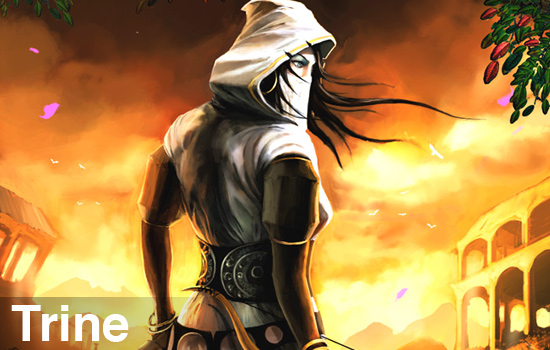

It's been a long time since I have played a platformer that has entertained me as much as Trine. In fact, I'll go ahead and say this up front: If you for some unfathomable reason do not fall completely head over heels in love with this game within the first ten minutes, there might be something wrong with your brain. I'd go get that checked out. For purposes of keeping the game as fresh as possible, I will try to avoid spitting out too many examples of how to solve puzzles.
I was surprised the first time I played Trine. Not by the lush, colorful graphics or the enchanting music, but by the superlative amount of charm it exudes. In addition to the fairytale aesthetic, a well-voiced (and written) narrator helps weave the tale of three unwilling companions: a lithe, acrobatic thief who comes with a grappling hook and bow, a lecherous wizard who has the ability to conjure objects at will, and a portly knight, whose bravery is only matched by his hunger. Each character is given a ton of personality, especially when they comment on the situation at hand or bicker over who gets to equip items found in the world. Combined with the narration, the game wins you over with its simple, but effective tale.

Our heroes managed to get themselves into a bit of a pickle, you see. They all managed to touch a magical artifact, conveniently called the Trine (ahh, and we have our title!), which bound their souls to one another, forcing them to traipse all over the world in search of a way to remove their curse. As is only natural, the world just so happens to be made up of a path of puzzles, both platforming and physics-based, and can be solved in numerous ways by creative manipulation of the characters. In the single-player mode, you are given the ability to switch between all three on the fly. Mixed in with the platforming segments are plenty of enemies, who unfortunately have a tendency to infinitely respawn using the Call of Duty model of clown car-based distribution. Hitting a checkpoint or advancing the screen a suitable distance will often end their barrage.
Sprinkled around the world are experience vials, often hidden in hard-to-reach places. For every fifty vials you pick up, your characters will gain a level and earn some skill points. Each character has three skills that each have three levels of power, and depending on your play style you'll be able to focus your characters' progression. Want to create nothing but bridges with the Wizard? Go right ahead. Do you think it would be awesome for the Knight to have a flaming sword? Spend some points! In addition to the experience vials, there are special treasure chests placed around the world, often in plain sight, but always slightly out of reach and filling you with a burning desire to open them. Inside are items that enhance your characters' abilities, often serving to reduce damage or give them creative ways to recharge their energy bar.
However, this game has co-op, and the marvelous puzzle mechanics have to work for up to three players as well as for one, and for the most part, they do. The game plays slightly differently depending on how many players you bring along, as each player controls one of the characters. In a two-player game, either player may switch to whatever the remaining class would be, but it will take an enormous amount of communication to determine who takes over and when. Three players is ideal, as each character will be represented at all times- the Knight can cover everything combat-wise while the Wizard and Thief work on navigating the world and doing their part so solve the puzzles.
The challenge is raised considerably in co-op, because you will need to make sure that each character can make their own way through the world instead of just whoever you choose to control, and being able to master combinations of moves is critical. The Knight can use his shield to block fireballs that would otherwise be harder to avoid by the Wizard, the Wizard can attach wooden blocks to ceiling spikes that create a new path for the Thief to grapple on, and the Thief can reach plenty of areas neither of the other characters can. Your range of motion is limited to the edge of the screen, and though the camera will pan back a bit to allow for more movement, you will eventually get teleported back together.
I played the PC version of Trine, and though you are able to play using a mouse and keyboard combination, it is far easier to play using a gamepad. As it happens, the game natively supports the Xbox 360 controller, so if you've got a spare wired controller (or sprung for the wireless receiver for your computer) lying around, plug that bad boy in. Unfortunately, the lack of online play did nothing to help enable decent co-op sessions for me. Getting a crowd of people to a.) huddle around a desk (barring someone hooking their PC up to their HDTV) and b.) have three suitable gamepads to play on is a chore. While the developers have alluded to a possible patch to enable online co-op, it doesn't exactly help players now.
When all is said and done, Trine is one of the finest, most charming puzzle platformers I have ever played, and though I would normally remain platform-agnostic, I would have to recommend co-op players lean towards the upcoming PSN release, if only because the couch co-op will be easier to manage, and you won't have to stick someone with the keyboard.